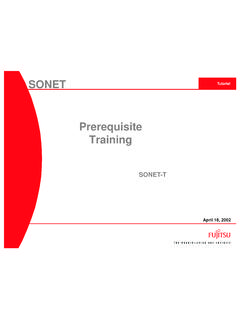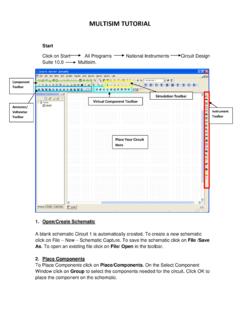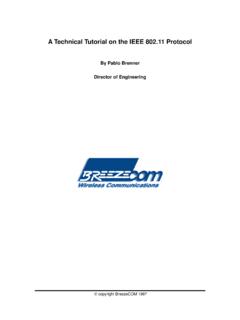Transcription of Welcome! Virtual tutorial starts at 15:00 BST - archer.ac.uk
1 Welcome! Virtual tutorial starts at 15:00 BST Parallel IO and the ARCHER Filesystem ARCHER Virtual tutorial , Wed 8th Oct 2014 David Henty Reusing this material This work is licensed under a Creative Commons Attribution-NonCommercial-ShareAlike International License. This means you are free to copy and redistribute the material and adapt and build on the material under the following terms: You must give appropriate credit, provide a link to the license and indicate if changes were made. If you adapt or build on the material you must distribute your work under the same license as the original. Note that this presentation contains images owned by others.
2 Please seek their permission before reusing these images. Overview Why parallel IO is difficult The Lustre file system Standard parallel IO strategies MPI-IO Tuning Lustre Why is Parallel IO Difficult? Difficult in principle combine distributed data into a single location data access patterns surprisingly complicated Difficult in practice individual disk IO speeds are not very fast file systems are complicated parallel file systems are even more complicated IO performance achieved by using multiple disks at once 1 2 3 4 1 2 3 4 1 2 3 1 2 3 4 Process 4 Process 2 Process 1 Process 3 1 2 3 4 5 6 7 8 9 10 11 12 13 14 15 16 4 Programmer View vs Machine View 1 2 3 4 4x4 array on 2x2 Process Grid Parallel Data File 1 2 3 4 1 2 3 4 1 2 3 4 1 2 3 4 1 2 3 4 1 2 3 4 1 2 3 4 C O M P U T E |
3 S T O R E | A N A L Y Z EARCHER s Lustre Cray Sonexion Storage 8 2 x OSSs and 8 x OSTs (Object Storage Targets) Contains Storage controller, Lustre server, disk controller and RAID engine Each unit is 2 OSSs each with 4 OSTs of 10 (8+2) disks in a RAID6 array SSU: Scalable Storage Unit MMU: Metadata Management Unit Lustre MetaData Server Contains server hardware and storage Multiple SSUs are combined to form storage racks C O M P U T E | S T O R E | A N A L Y Z EARCHER s File systems /fs2 6 SSUs 12 OSSs 48 OSTs 480 HDDs 4TB per HDD PB Total /fs3 6 SSUs 12 OSSs 48 OSTs 480 HDDs 4TB per HDD PB Total /fs4 7 SSUs 14 OSSs 56 OSTs 560 HDDs 4TB per HDD PB Total Infiniband Network Connected to the Cray XC30 via LNET router service nodes.
4 C O M P U T E | S T O R E | A N A L Y Z ELustre data striping 10 Single logical user file /work/y02/y02/ted OS/file-system automatically divides the file into stripes Stripes are then read/written to/from their assigned OST Lustre s performance comes from striping files over multiple OSTs C O M P U T E | S T O R E | A N A L Y Z ELustre Client Object Storage Server (OSS) + Object Storage Target (OST) Object Storage Server (OSS) + Object Storage Target (OST) Open name permissions attributes location Metadata Server (MDS) OSTs Lustre Client Read/write Opening a file 11 The client sends a request to the MDS to opening/acquiring information about the file The MDS then passes back a list of OSTs For an existing file, these contain the data stripes For a new files.
5 These typically contain a randomly assigned list of OSTs where data is to be stored Once a file has been opened no further communication is required between the client and the MDS All transfer is directly between the assigned OSTs and the client Summary Lustre achieves high bandwidth via multiple disks Single file can be striped across multiple disks allows simultaneous IO from multiple Object Storage Targets think of each OST as a separate IO path to disk Optimised for large transactions please write 100 Mb to disk Meta Data Server can be a bottleneck opening and closing files is serialised and can be slow not optimised for large numbers of small files C O M P U T E | S T O R E | A N A L Y Z EI/O strategies.
6 Spokesperson (master/serial IO) 13 One process performs I/O Data Aggregation or Duplication Limited by single I/O process Easy to program Pattern does not scale Time increases linearly with amount of data Time increases with number of processes Care has to be taken when doing the all-to-one kind of communication at scale Can be used for a dedicated I/O Server Bottlenecks Lustre clients C O M P U T E | S T O R E | A N A L Y Z EI/O strategies: Multiple Writers Multiple Files 14 All processes perform I/O to individual files Limited by file system Easy to program Pattern may not scale at large process counts Number of files creates bottleneck with metadata operations Number of simultaneous disk accesses creates contention for file system resources 9 10 13 14 2x2 to 1x4 Redistribution write 1 2 3 4 5 6 7 8 11 12 15 16 1 2 5 6 3 4 7 8 9 10 13 14 11 12 15 16 read 1 3 9 11 2 4 10 12 5 7 13 15 14 16 6 8 reorder C O M P U T E | S T O R E | A N A L Y Z EI/O strategies.
7 Multiple Writers Single File 16 Each process performs I/O to a single file which is shared. Performance Data layout within the shared file is very important. At large process counts contention can build for file system resources. Not all programming languages support it C/C++ can work with fseek No real Fortran standard C O M P U T E | S T O R E | A N A L Y Z EI/O strategies: Collective IO to single or multiple files 17 Aggregation to a processor in a group which processes the data. Serializes I/O in group. I/O process may access independent files. Limits the number of files accessed.
8 Group of processes perform parallel I/O to a shared file. Increases the number of shares to increase file system usage. Decreases number of processes which access a shared file to decrease file system contention. Summary Need subgroups of IO processes to do IO simultaneously too many and there is contention for file system resources too few and we do not use all the OSTs Far too complicated to do this ourselves need some library to help us out For example, MPI-IO part of MPI standard since MPI-IO Approach Each process / rank tells MPI-IO what portion(s) of the file it wants to read / write uses MPI Derived Datatypes this is called the File View Tell MPI-IO what data to write automatically goes to the position(s)
9 Selected by the file view all the communications / buffering / aggregation handled by MPI-IO Allows for collective IO MPI-IO has a global view can aggregate data for a small number of large IO transactions Combining File Views 1 2 3 4 5 6 7 8 9 10 11 12 13 14 15 16 rank 0 (0,0) rank 1 (0,1) rank 3 (1,1) rank 2 (1,0) rank 0 rank 1 rank 3 rank 2 Collective IO Combine ranks 0 and 1 for single contiguous read/write to file Combine ranks 2 and 3 for single contiguous read/write to file MPI-IO on ARCHER Optimised for the Lustre file system Scales the number of IO processes appropriate to the number of OSTs and the total number of processes But.
10 The striping of a file (the number of OSTs) is set by the user important to get this right Lustre Striping Essential to stripe large files across multiple disks but striping small files across many disks is bad Default striping on ARCHER is across 4 OSTs Can set this yourself using: lfs setstripe -c <nstripe> <directory> to use all the OSTs: nstripe = -1 to enquire: lfs getstripe <directory> Test case: large 3D dataset across 3D process grid IO done using MPI-IO 1283 per proc: 16 MiB to 64 GiB Summary Master IO unaffected by striping Same bandwidth as parallel IO with no striping Around 400 MiB/s independent of process count With parallel IO and striping bandwidth scales with process count (until all OSTs are used) achieve around 2 GiB/s for default striping (4 OSTs) 10 s of GiB/s for full striping (all OSTs, nstripe = -1)







